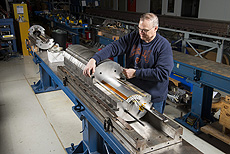LARP completes first successful test of High-Luminosity LHC coil
 |
Steve Gould of the Technical Division prepares a cold test of a short quadrupole coil. The coil is of the type that would go into the High-Luminosity LHC. Photo: Reidar Hahn |
Last month, a group collaborating across four national laboratories completed the first successful tests of a superconducting coil in preparation for the future high-luminosity upgrade of the Large Hadron Collider, or HL-LHC. These tests indicate that the magnet design may be adequate for its intended use.
Physicists, engineers and technicians of the U.S. LHC Accelerator Research Program (LARP) are working to produce the powerful magnets that will become part of the HL-LHC, scheduled to start up around 2025. The plan for this upgrade is to increase the particle collision rate, or luminosity, by approximately a factor of 10, so expanding the collider's physics reach by creating 10 times more data.
"The upgrade will help us get closer to new physics. If we see something with the current run, we'll need more data to get a clear picture. If we don't find anything, more data may help us to see something new," said Technical Division's Giorgio Ambrosio, leader of the LARP magnet effort.
LARP is developing more advanced quadrupole magnets, which are used to focus particle beams. These magnets will have larger beam apertures and the ability to produce higher magnetic fields than those at the current LHC.
The Department of Energy established LARP in 2003 to contribute to LHC commissioning and prepare for upgrades. LARP includes Brookhaven National Laboratory, Fermilab, Lawrence Berkeley National Laboratory and SLAC. Its members began developing the technology for advanced large-aperture quadrupole magnets around 2004.
The superconducting magnets currently in use at the LHC are made from niobium titanium, which has proven to be a very effective material to date. However, they will not be able to support the higher magnetic fields and larger apertures the collider needs to achieve higher luminosities. To push these limits, LARP scientists and engineers turned to a different material, niobium tin.
Niobium tin was discovered before niobium titanium. However, it has not yet been used in accelerators because, unlike niobium titanium, niobium tin is very brittle, making it susceptible to mechanical damage. To be used in high-energy accelerators, these magnets need to withstand large amounts of force, making them difficult to engineer.
LARP worked on this challenge for almost 10 years and went through a number of model magnets before it successfully started the fabrication of coils for 150-millimeter-aperture quadrupoles. Four coils are required for each quadrupole.
LARP and CERN collaborated closely on the design of the coils. After the first coil was built in the United States earlier this year, the LARP team successfully tested it in a magnetic mirror structure. The mirror structure makes possible tests of individual coils under magnetic field conditions similar to those of a quadrupole magnet. At 1.9 Kelvin, the coil exceeded 19 kiloamps, 15 percent above the operating current.
The team also demonstrated that the coil was protected from the stresses and heat generated during a quench, the rapid transition from superconducting to normal state.
"The fact that the very first test of the magnet was successful was based on the experience of many years," said TD's Guram Chlachidze, test coordinator for the magnets. "This knowledge and experience is well recognized by the magnet world."
Over the next few months, LARP members plan to test the completed quadrupole magnet.
"This was a success for both the people building the magnets and the people testing the magnets," said Fermilab scientist Giorgio Apollinari, head of LARP. "We still have a mountain to climb, but now we know we have all the right equipment at our disposal and that the first step was in the right direction."
—Diana Kwon
|